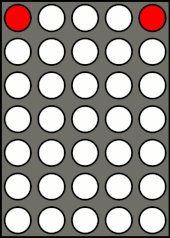Matrix display

A matrix display (English dot-matrix display ) is an optical display that consists of individual pixels in a matrix of horizontal lines and vertical columns. Each individual pixel is clearly defined by specifying a row and a column number.
Depending on the display technology used, such as liquid crystal displays (LCD), light-emitting diodes (LED) or historically in the form of glow lamps or as an electromechanical display , a pixel can assume two or more gray levels or several colors. In the simplest case, an image point is visible or invisible, black or white, within the display area. By controlling several points and a correspondingly fine arrangement of the individual image points, any graphic patterns or characters can be composed from several neighboring image points of the matrix.
In the case of LCDs and OLEDs, a distinction is made between two types of control technology: passive matrix displays and active matrix displays (also called TFT displays). The individual pixels of the matrix are controlled by a control circuit. This control circuit is usually implemented as an integrated circuit (IC), for example the HD44780 circuit , and, in addition to controlling the individual pixels, also includes a character generator .
literature
- Ekbert Hering , Klaus Bressler, Jürgen Gutekunst: Electronics for engineers and natural scientists . 6th, fully updated and expanded edition. Springer Vieweg, Berlin et al. 2014, ISBN 978-3-642-05499-0 , p. 335-336 .


